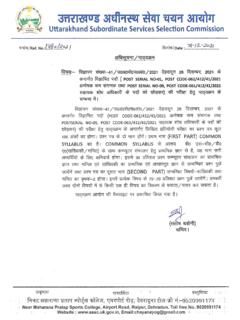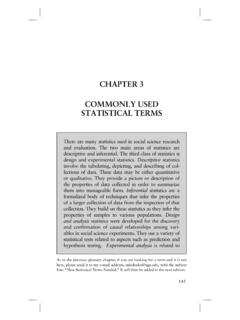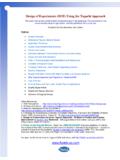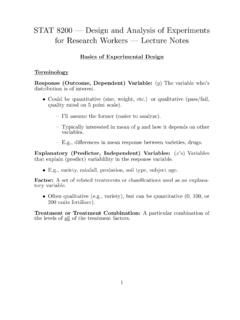Transcription of STATISTICAL METHODS - University of California, San Diego
1 STATISTICAL METHODS 1 STATISTICAL METHODS Arnaud Delorme, Swartz Center for Computational Neuroscience, INC, University of San Diego California, CA92093-0961, La Jolla, USA. Email: Keywords: STATISTICAL METHODS , inference, models, clinical, software, bootstrap, resampling, PCA, ICA Abstract: Statistics represents that body of METHODS by which characteristics of a population are inferred through observations made in a representative sample from that population. Since scientists rarely observe entire populations, sampling and STATISTICAL inference are essential.
2 This article first discusses some general principles for the planning of experiments and data visualization. Then, a strong emphasis is put on the choice of appropriate standard STATISTICAL models and METHODS of STATISTICAL inference. (1) Standard models (binomial, Poisson, normal) are described. Application of these models to confidence interval estimation and parametric hypothesis testing are also described, including two-sample situations when the purpose is to compare two (or more) populations with respect to their means or variances.
3 (2) Non-parametric inference tests are also described in cases where the data sample distribution is not compatible with standard parametric distributions. (3) Resampling METHODS using many randomly computer-generated samples are finally introduced for estimating characteristics of a distribution and for STATISTICAL inference. The following section deals with METHODS for processing multivariate data. METHODS for dealing with clinical trials are also briefly reviewed. Finally, a last section discusses STATISTICAL computer software and guides the reader through a collection of bibliographic references adapted to different levels of expertise and topics.
4 Statistics can be called that body of analytical and computational METHODS by which characteristics of a population are inferred through observations made in a representative sample from that population. Since scientists rarely observe entire populations, sampling and STATISTICAL inference are essential. Although, the objective of STATISTICAL METHODS is to make the process of scientific research as efficient and productive as possible, many scientists and engineers have inadequate training in experimental design and in the proper selection of STATISTICAL analyses for experimentally acquired data.
5 John L. Gill [1] states: .. STATISTICAL analysis too often has meant the manipulation of ambiguous data by means of dubious METHODS to solve a problem that has not been defined. The purpose of this article is to provide readers with definitions and examples of widely used concepts in statistics. This article first discusses some general principles for the planning of experiments and data visualization. Then, since we expect that most readers are not studying this article to learn statistics but instead to find practical METHODS for analyzing data, a strong emphasis has been put on choice of appropriate standard STATISTICAL model and STATISTICAL inference METHODS (parametric, non-parametric, resampling METHODS ) for different types of data.
6 Then, METHODS for processing multivariate data are briefly reviewed. The section following it deals with clinical trials. Finally, the last section discusses computer software and guides the reader through a collection of bibliographic references adapted to different levels of expertise and topics. DATA SAMPLE AND EXPERIMENTAL DESIGN Any experimental or observational investigation is motivated by a general problem that can be tackled by answering specific questions. Associated with the general problem will be a population.
7 For example, the population can be all human beings. The problem may be to estimate the probability by age bracket for someone to develop lung cancer. Another population may be the full range of responses of a medical device to measure heart pressure and the problem may be to model the noise behavior of this apparatus. Often, experiments aim at comparing two sub-populations and determining if there is a (significant) difference between them. For example, we may compare the frequency occurrence of lung cancer of smokers compared to non-smokers or we may compare the signal to noise ratio generated by two brands of medical devices and determine which brand outperforms the other with respect to this measure.
8 How can representative samples be chosen from such populations? Guided by the list of specific questions, samples will be drawn from specified sub-populations. For example, the study plan might specify that 1000 presently cancer-free persons will be drawn from the greater Los Angeles area. These 1000 persons would be composed of random samples of specified sizes of smokers and non-smokers of varying ages and occupations. Thus, the description of the sampling plan will imply to some extent the nature of the target sub-population, in this case smoking individuals.
9 Choosing a random sample may not be easy and there are two types of errors associated with choosing representative samples: sampling errors and non-sampling errors. Sampling errors are those errors due to chance variations resulting from sampling a population. For example, in a population of 100,000 individuals, suppose that 100 have a certain genetic trait and in a (random) sample of 10,000, 8 have the trait. The experimenter will estimate that 8/10,000 of the population or 80/100,000 individuals have the trait, and in doing so will have underestimated the actual percentage.
10 Imagine conducting this experiment ( , drawing a random sample of 10,000 and examining for the trait) repeatedly. The observed number of sampled individuals having the trait will fluctuate. This phenomenon is called the sampling error. Indeed, if sampling STATISTICAL METHODS 2is truly random, the observed number having the trait in each repetition will fluctuate randomly about 10. Furthermore, the limits within which most fluctuations will occur are estimable using standard STATISTICAL METHODS .








